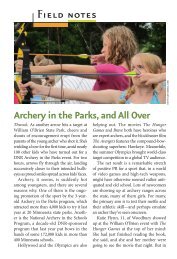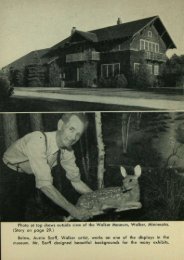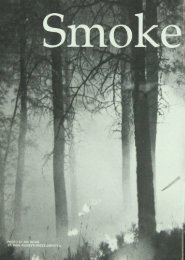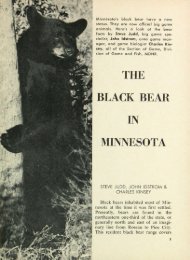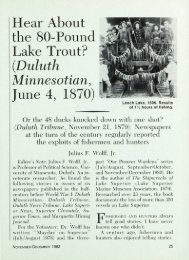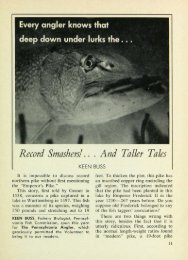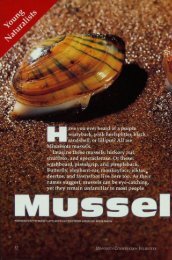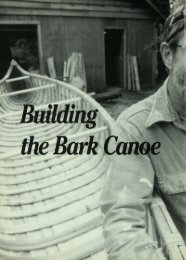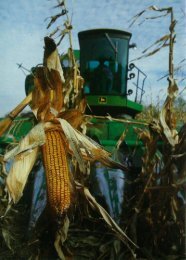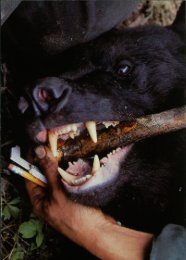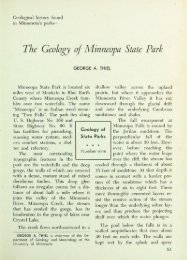1945 Windbreaks: Natural Erosion Control - webapps8
1945 Windbreaks: Natural Erosion Control - webapps8
1945 Windbreaks: Natural Erosion Control - webapps8
You also want an ePaper? Increase the reach of your titles
YUMPU automatically turns print PDFs into web optimized ePapers that Google loves.
panding irrigation areas, have suffered<br />
soil losses because of windbreak removal.<br />
Benton County commissioners<br />
have passed an ordinance controlling<br />
removal of windbreaks, one of the few<br />
such laws in the nation. It requires<br />
farmers to develop alternative plans<br />
for soil conservation before they can<br />
remove a field windbreak. Kevin Adelman,<br />
SCS technician for the two<br />
counties, said the ordinance has cut<br />
windbreak removal in half.<br />
About 30 miles of windbreaks have<br />
been removed in Benton and Sherburne<br />
counties, mainly because of new<br />
irrigation projects. But only two miles<br />
have been replaced. William Held of<br />
Rice has started to replace some of the<br />
six miles of shelterbelt he removed,<br />
planting trees on the perimeter of his<br />
fields. (<strong>Windbreaks</strong> on the outside of a<br />
field do not offer the protection of<br />
single-row windbreaks every 600 feet.<br />
However, SCS endorses their use in<br />
combination with other soil conservation<br />
methods.)<br />
"Most farmers in the two counties<br />
have begun a program of minimum<br />
tillage or mulch tillage in an effort to<br />
protect the soil," said Adelman. One<br />
landowner, Joe Gottward of Rice,<br />
moved part of his windbreak out of<br />
the way of his center pivot system and<br />
replanted the trees elsewhere. Other<br />
farmers have attempted to replant, but<br />
dry weather in 1975 and 1976 killed<br />
the young trees. Farmers indicate that,<br />
if they receive enough snow this winter,<br />
they will try again next spring.<br />
Many soil experts believe that windbreaks<br />
not only will prevent wind<br />
erosion on an irrigated field, but will<br />
make the unit more efficient. Water<br />
can be distributed better with less<br />
evaporation if a windbreak adjoins the<br />
pivot system.<br />
Irrigation isn't the only cause of<br />
windbreak removal. In the Red River<br />
Valley, windbreaks of Siberian elm<br />
planted about 15 years ago are now<br />
dying. "The fungus has been isolated,<br />
but it is a secondary cause of death,"<br />
said Scottie Scholten, University of<br />
Minnesota College of Forestry professor.<br />
"The trees have been weakened<br />
by annual crop spraying."<br />
John Hultgren, SCS Woodland Conservationist<br />
in Minnesota, agrees that<br />
crop spray may damage windbreaks of<br />
Siberian elm. "Monoculture is always a<br />
problem," he said. "Siberian elm<br />
looked like the perfect tree, so that<br />
was all that was planted. Today we<br />
encourage a variety of trees in a<br />
shelterbelt, such as a mixture of Siberian<br />
elm, green ash, and cottonwood.<br />
This decreases the likelihood of<br />
disease and insect infestation as well as<br />
the chance of crop spray wiping out<br />
the entire shelterbelt."<br />
The SCS, U.S. Forest Service Extension<br />
Service, and the University of<br />
Minnesota Experiment Stations are<br />
constantly searching for new seedstock<br />
and alternative species to use in field<br />
windbreaks. "We are now looking at a<br />
seed source which will give us a ponderosa<br />
pine with more upright<br />
branches for better snow distribution<br />
across the field," said Scholten. "This<br />
)ANUA RY —FEBRUARY 1978 39





